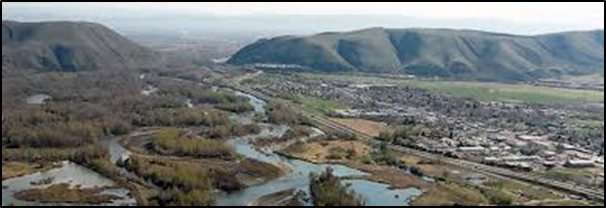Yakima River Basin Plans for Future Water Availability

Water from the Yakima River Basin, located within Washington State, supports municipal, agricultural, tribal, and environmental uses. These uses have been significantly impacted by previous droughts, and the projected influence of climate change on drought frequency is anticipated to further challenge state officials and water managers in maintaining water quantity and quality. While drought intensity during the driest years is projected to be largely unchanged from present conditions, the frequency of drought is projected to increase significantly. Projections show that climate change can bring earlier and reduced snowmelt leading to possible increased curtailment of water deliveries to agricultural water rights holders. Historically, curtailments have occurred on average once every seven years, and without planning for climate change, projections indicate that curtailments could increase to once every three years in the 2040’s and three of every four years by 2080.
To account for the projected increase in drought conditions in the Yakima River Basin, the Washington State Department of Environmental Quality and the U.S. Department of the Interior formed a working group to develop a water resource management plan that includes the operational flexibility to manage water flows under changing climate conditions. The working group included representatives from the Yakama Tribal Nation, local irrigation districts and environmental organizations, as well as federal, state, county, and city governments. Climate change projections were provided by, among others, the University of Washington’s Climate Impacts Group.
The workgroup’s efforts contributed to development of the Yakima River Basin Integrated Water Resource Management Plan, which was completed in 2012. This 30-year, $3.8 billion plan outlines a comprehensive strategy, including actions to mitigate drought conditions (e.g., $100 million for salmon restoration projects). While the Plan’s primary focus is on drought and associated water quantity impacts, water quality can also be adversely affected by drought. Consequently, many of the Plan’s actions – such as land acquisition, restoration of natural streamflow, and improved timing of water release from dams – address water quality and water quantity concerns. By considering future climate in the Yakima River Basin Integrated Water Resource Plan, local stakeholder groups are taking an adaptive management approach to safeguarding water quality and quantity even as the climate changes.
|
How Did They Do It? |
Applicable EPA Tools |
|---|---|
|
Used climate projections to anticipate future climate threats
|
The National Climate Assessment includes regional climate projections and summaries of climate threats. National Climate Assessment (NCA5) *Note: These are non-EPA resources. |
|
Developed an adaptation plan that incorporates strategies to prepare the Yakima Basin to maintain water quantity, provide fish habitat, and co-benefit water quality for climate change
|
EPA’s Climate Change Handbook for Regional Water Planning provides a framework for considering climate change in water management planning. Climate Change Handbook for Regional Water Planning The Forest Service’s (USFS) NorWeST -Stream Temp can help identify projected temperature changes in streams in the West. *Note: This is a non-EPA tool. The related USFS and US Department of Agriculture (USDA) Climate Shield can help identify changes to trout coldwater habitats related to changing temperatures. Climate Shield Cold-Water Refuge Streams for Native Trout *Note: This is a non-EPA tool. |
Similar Cases and More Information
To learn more about this effort, view the “An Integrated Plan for Water and Long-Term Ecological Resilience” case study on the U.S. Climate Resilience Toolkit. To view another water management example that protects water quality and fish habitat, view the “Pennsylvania Protects Coldwater Fisheries and Water Quality from Climate Change” case study to see how Pennsylvania is preparing to support coldwater fisheries even as the climate changes.
References
The following links exit the site

